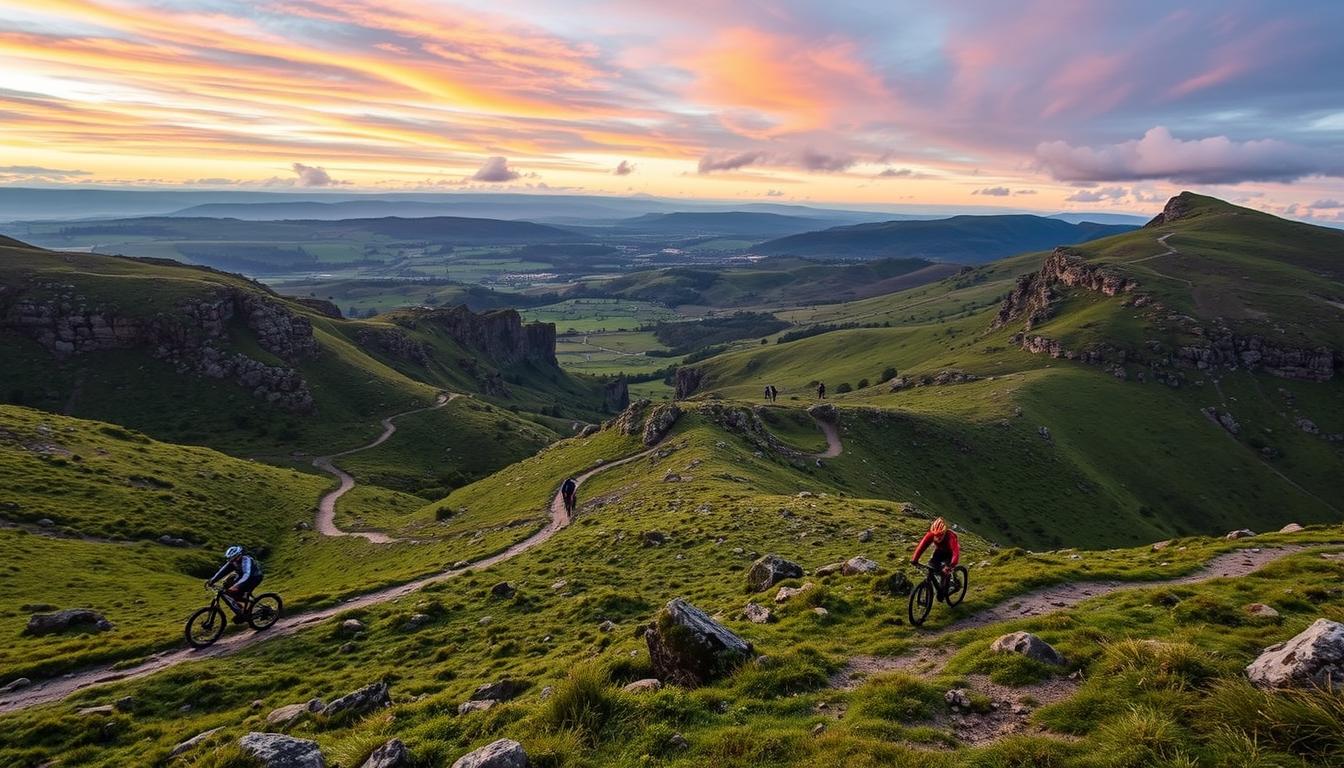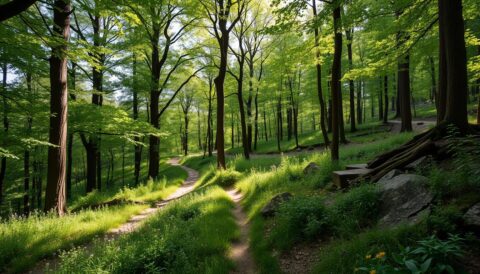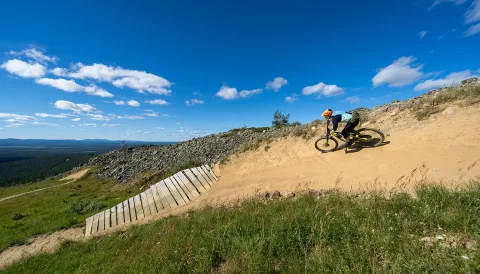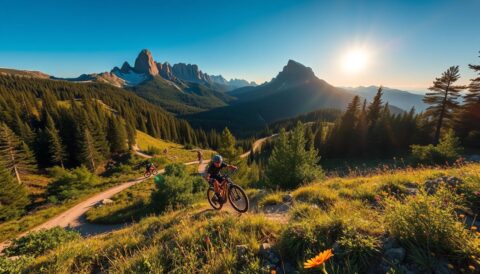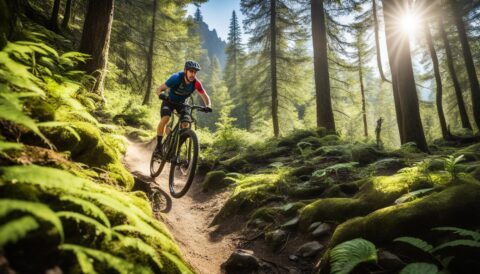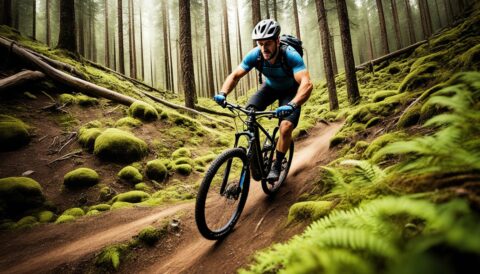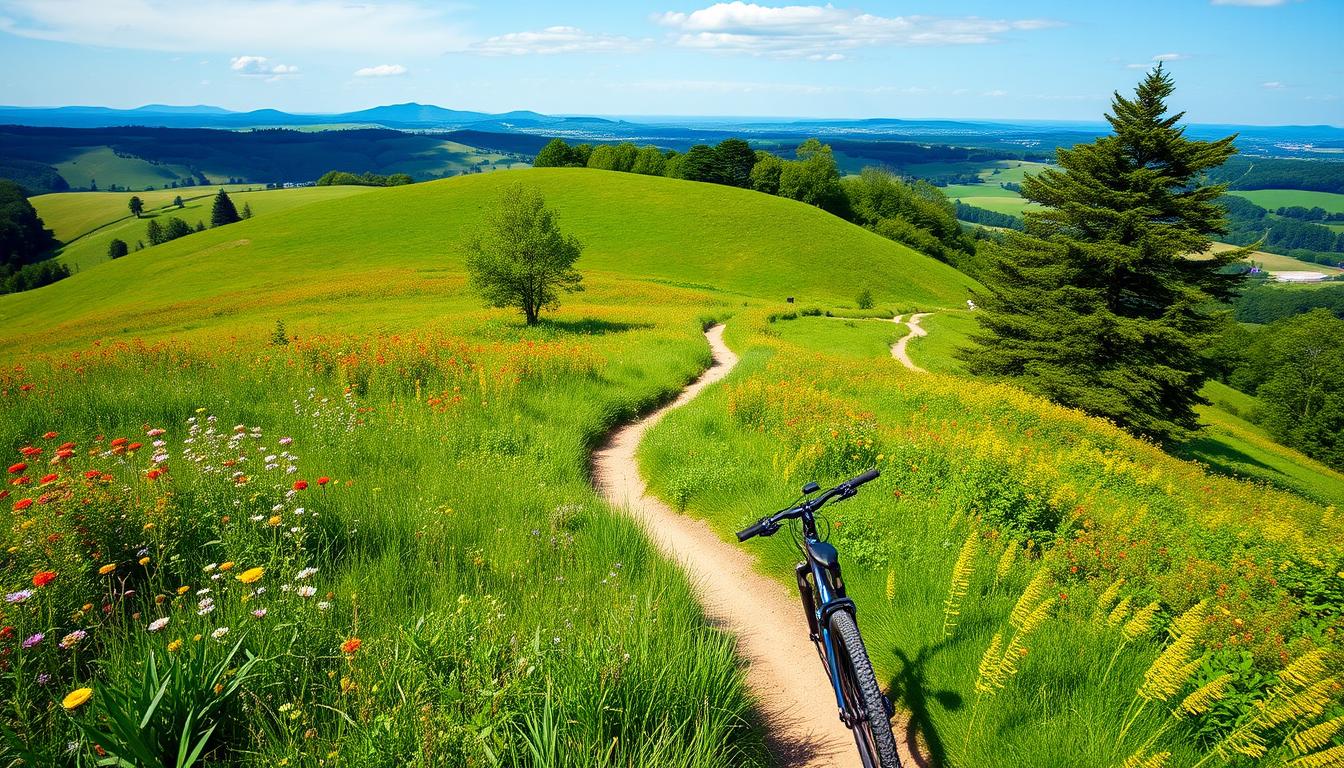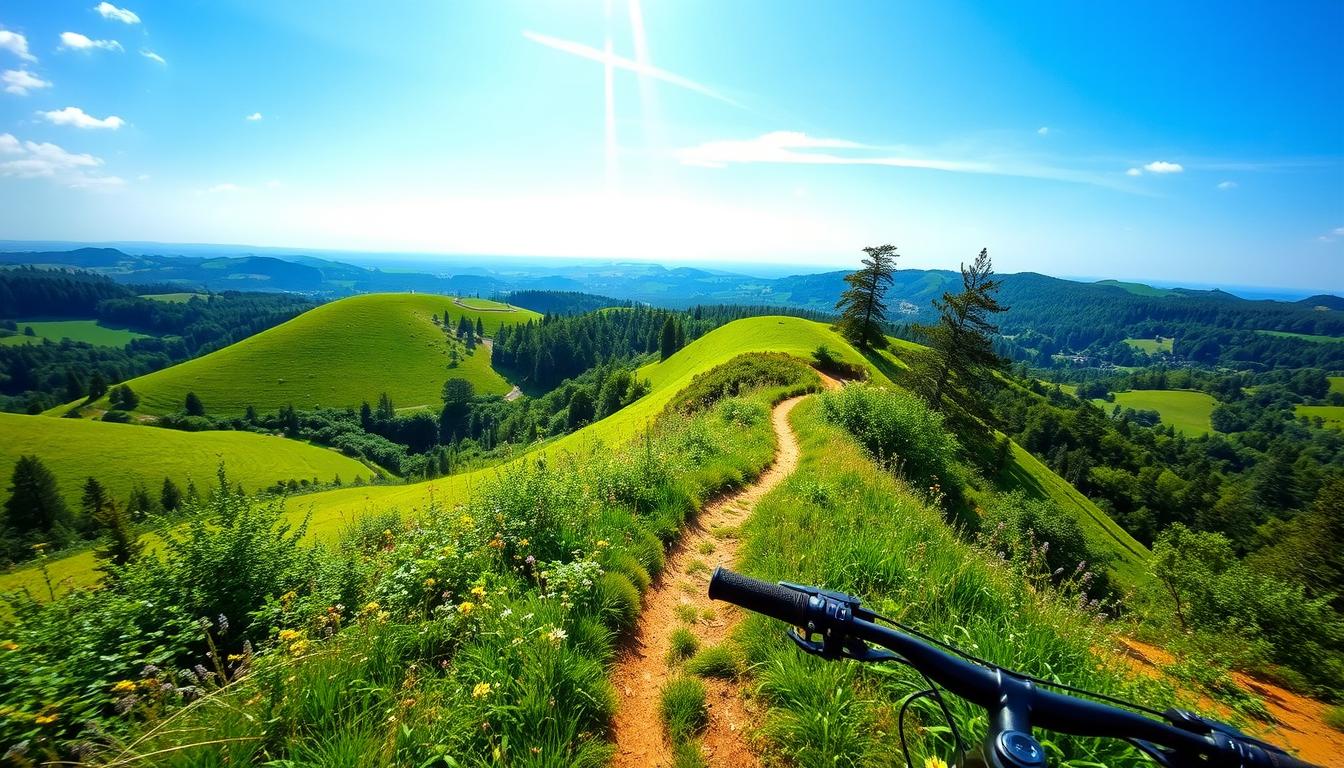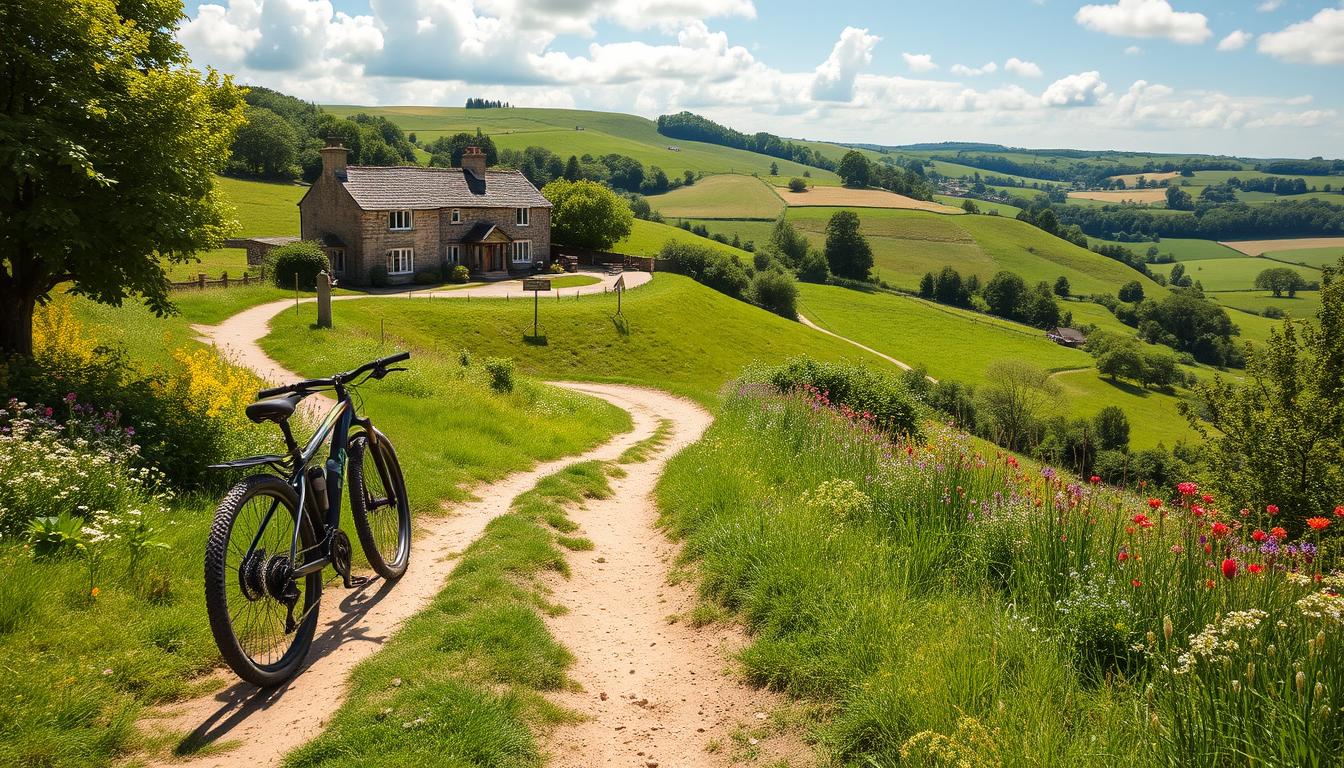The Peak District, nestled in England’s heart, is a mountain biker’s paradise. This national park boasts diverse mountain bike routes for all skill levels. From gentle paths to challenging trails, there’s something for everyone.
Peak District mountain biking offers an exhilarating adventure. Trail difficulties range from easy (30%) to severe (10%). Beginners can enjoy gentle paths, while experienced cyclists tackle technical descents.
Jon Barton’s guidebook, “Peak District Mountain Biking”, details 26 routes from 9km to 105km. These trails showcase rocky surfaces, berms, drop-offs, and tight singletracks.
Most Peak District trails (70%) require intermediate to advanced fitness. Well-marked routes and stunning scenery make this area a top cycling destination. Mountain biking here promises a unique and thrilling experience.
Introduction to Peak District Mountain Biking
The Peak District is a top spot for mountain biking fans. It offers a stunning landscape that tests riders of all levels. This national park provides an unmatched cycling experience, drawing adventurers from across the UK.
Why the Peak District is a Mountain Biking Haven
The Peak District’s varied geography attracts mountain bikers. It boasts an impressive network of MTB trails through breathtaking scenery. Cyclists can explore ancient packhorse routes and natural paths shaped over centuries.
The area also offers technical rocky sections and flowing single tracks. These features create a diverse riding experience for all skill levels.
- Ancient packhorse routes
- Natural trails shaped by centuries of use
- Technical rocky sections
- Flowing single tracks
“The Peak District offers more than just trails; it provides a complete mountain biking journey through history and natural beauty.”
Understanding the Terrain and Landscape
The terrain varies greatly between the Dark Peak and White Peak areas. Riders face rocky paths, limestone plateaus, and rolling moorlands. These features test both technical skills and endurance.
The diverse geology creates an unpredictable and exciting mountain biking experience. Each ride offers new challenges and stunning views.
Best Seasons for Riding
Each season in the Peak District offers a unique cycling experience. Spring and autumn have the best trail conditions with mild temperatures. Summer brings longer days, while winter offers challenging but rewarding routes.
- Spring/Autumn: Best overall riding conditions
- Summer: Extended daylight, busier trails
- Winter: Technical challenges, fewer crowds
Local group Peak District MTB works to improve trail access. They campaign to expand the current 11% of bike-accessible rights of way.
Essential Trail Networks and Routes
The Peak District offers a vast network of mountain bike routes. These trails cater to all skill levels across nearly 1,500 square kilometres. Cyclists can enjoy diverse landscapes and breathtaking scenery throughout the area.
Popular cycling paths wind through the Dark Peak and White Peak regions. These MTB trail networks provide unique experiences across different geological landscapes. Riders can explore various terrains and challenges.
- High Peak Trail: A family-friendly, traffic-free route perfect for beginners
- Tissington Trail: Scenic path offering gentle gradients and stunning views
- Black Harry Trails: Advanced routes covering nearly 20km in the Longstone Edge area
“The Peak District offers mountain biking routes that transform every ride into an adventure” – Local Cycling Guide
Key cycling areas include the Hope Valley, Ladybower Reservoir, and historic Monsal Trail. Routes range from 9km to 105km, catering to various skill levels. Cyclists can find trails suited to their endurance and experience.
The Black Harry Trails offer technical challenges for advanced riders. These routes showcase the region’s mining heritage and limestone landscapes. Community efforts have developed these exceptional mountain biking experiences.
- Route difficulty levels vary from beginner to expert
- Multiple access points throughout the national park
- Cycle hire services available at key locations
The Peak District’s extensive trail networks promise unforgettable cycling adventures. From novice riders to seasoned mountain bikers, everyone can find their perfect route.
Riding the Peak District by MTB: Dark Peak vs White Peak
The Peak District offers two distinct mountain biking landscapes: the rugged Dark Peak and gentler White Peak. Each area presents unique challenges for riders of various skill levels.
The Peak District’s diverse terrain provides an extraordinary playground for mountain bikers. Knowing the differences between Dark Peak and White Peak routes is key for planning thrilling cycling adventures.
Dark Peak: Technical Terrain and Challenging Trails
Dark Peak mountain biking offers demanding landscapes with millstone grit and rocky terrain. This region tests cyclists’ skills with technical challenges.
- Cut Gate trail provides approximately 7 kilometres of exceptional singletrack
- Mam Tor features a famous paved sandstone slab trail
- Stanage Plantation offers technically challenging descents
- Edale and Castleton area boasts 4 excellent bike routes
White Peak: Smooth Riding and Scenic Routes
White Peak routes offer a smoother experience compared to Dark Peak’s ruggedness. The limestone terrain creates flowing trails ideal for intermediate riders.
- The Loop south of Calver provides scenic touring opportunities
- Curbar & Froggat Edges offer minimal climbing routes
- Monsal Trail presents gentler riding conditions
MTB Difficulty Levels and Trail Considerations
Mountain bike difficulty levels in the Peak District vary greatly. Riders should be ready for changing terrain and unpredictable trail conditions.
Peak District trails demand adaptability and skilled navigation across diverse landscapes.
- Trail conditions can change rapidly
- Drainage differs between Dark and White Peak areas
- Dark Peak provides better grip and drainage
- White Peak tends to be muddier during winter months
Local riders suggest carrying proper gear, including LED bike lights for night rides. Waterproof equipment is also essential to handle changing weather conditions.
Navigation and Trail Access Rights
Navigating Peak District MTB trails requires careful planning and knowledge of local access rights. The vast network of paths demands excellent map-reading skills. Riders must respect established routes and understand the rights of way system.
Essential navigation tools for mountain bikers include:
- Ordnance Survey Explorer maps OL1 (Dark Peak) and OL24 (White Peak)
- Digital GPS devices with offline mapping capabilities
- Smartphone apps with detailed trail information
Grasping trail access rights is vital for responsible riding. The Peak District’s path network comprises:
- Bridleways: Open to cyclists, horse riders, and walkers
- Byways: Multi-use paths accessible to various users
- Footpaths: Restricted to walkers only
Peak District MTB strongly recommends cyclists use designated bridleways and respect local access guidelines.
The Peak District National Park Authority offers current information on permitted routes. Cyclists should check conditions, closures, and signage before setting off.
Ongoing campaigns aim to increase bridleway access, promising more trails in this stunning landscape. Mountain bikers exploring the Peak District can anticipate exciting new riding opportunities.
Essential Gear and Safety Equipment
Proper mountain bike gear is crucial for a great Peak District adventure. The right cycling clothing can transform your ride from challenging to enjoyable. Careful selection ensures comfort and safety throughout your journey.
The Peak District’s varied terrain demands robust equipment. Your gear must withstand diverse conditions. Choose items that offer durability and versatility for the best experience.
Recommended Bike Specifications
Your mountain bike should be equipped with:
- Disc brakes for superior stopping power
- Front suspension of at least 80mm
- Durable frame suitable for rough terrain
- Tubeless tyres for better puncture resistance
Weather-Appropriate Cycling Clothing
Peak District weather can change quickly. Invest in versatile cycling clothing for all conditions. Smart choices will keep you comfortable throughout your ride.
- Moisture-wicking base layers
- Waterproof outer layers
- Breathable fabrics
- Thermal protection for cooler conditions
Safety Equipment and Emergency Supplies
Preparation is your best defence on the trails.
Essential MTB safety equipment includes:
- Well-fitted helmet
- First-aid kit
- Emergency blanket
- Mobile phone with full charge
- Basic bike repair kit
- Extra water and nutrition
Always share your planned route with someone. Let them know your expected return time. This is especially important when exploring remote Peak District trails.
Local Bike Shops and Rental Services
The Peak District offers excellent options for bike hire and MTB rental. Cyclists can find diverse shops catering to all skill levels and preferences.
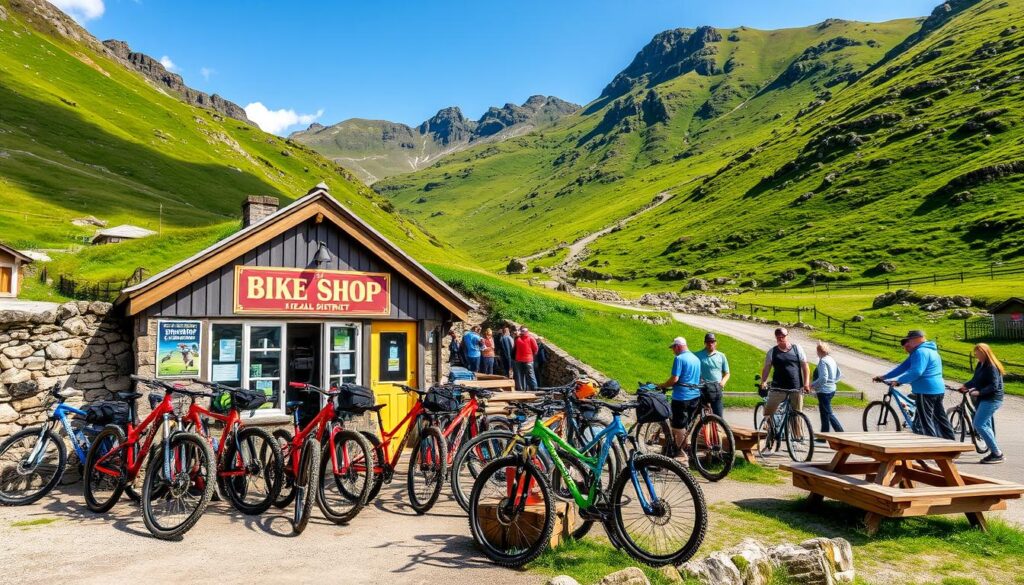
- 18 Bikes in Hope – specialising in mountain bike sales and expert servicing
- Bike Garage in Bamford – offering mountain bike and e-bike hire
- Monsal Trail Cycle Hire near Bakewell – providing basic bike rentals
- Blackwell Mill Cycle Hire near Buxton – comprehensive cycling services
- Derwent Cycle Hire at Fairholmes – versatile bike rental options
- Parsley Hay Cycle Hire on the High Peak Trail – extensive rental selection
*”Choosing the right bike rental service can transform your Peak District cycling experience”*
These shops offer more than just MTB rental. They provide local trail knowledge, equipment advice, and essential supplies for mountain biking adventures.
Most centres have flexible booking policies. They accept card payments and require photo identification.
Visitors can choose from a wide range of cycles, including:
- Adult standard bicycles
- Child cycles
- Electric bikes
- Tag-along bikes
- Children’s trailers
- Specialized trampers
Derbyshire boasts 430km of traffic-free trails and numerous cycling hubs. This makes the Peak District an ideal destination for mountain bike enthusiasts.
Trail Etiquette and Conservation
Mountain biking in the Peak District requires more than technical skills. It demands respect for the delicate ecosystem and diverse trail users. The UK’s first National Park offers a unique landscape that cyclists must approach thoughtfully.
The International Mountain Biking Association provides essential guidelines for MTB trail etiquette. These rules help riders navigate trails responsibly and safely.
- Always control your bicycle to prevent accidents
- Yield to other trail users, especially uphill cyclists
- Respect wildlife and local environments
- Stay on designated trails to minimise ecological impact
Sharing Trails with Other Users
Cycling conservation begins with mutual respect. The Be Nice Say Hi campaign promotes positive interactions between mountain bikers and other trail users. When meeting others, slow down and communicate clearly.
“Trails are shared spaces – respect creates harmony for everyone.”
Environmental Responsibility
Responsible mountain biking protects the landscapes we cherish. Avoid wet trails to prevent damage. Pack out all litter and stick to established routes.
Local Conservation Efforts
Groups like Ride Sheffield support trail maintenance and sustainable access. Mountain bikers can help by joining trail maintenance days. They can also promote responsible riding practices throughout the Peak District.
Conclusion
The Peak District offers cyclists an extraordinary mountain biking experience. Its diverse landscapes and challenging terrains test skills and reward exploration. Riders passionate about MTB adventures will find this region unmatched.
Responsible cycling is crucial for sustainable mountain biking. A survey shows 81% of people recognise the harm of improper trail use. Respecting local environments, fellow trail users, and access rights is vital.
Local bike shops and community support boost the area’s mountain biking potential. The region’s remarkable routes attract more cyclists as technology advances. The Peak District is set to become a top destination for mountain biking enthusiasts.
FAQ
What makes the Peak District a premier mountain biking destination?
The Peak District boasts diverse trails for all skill levels. It features unique terrain across the Dark Peak and White Peak areas. Ancient packhorse routes, natural trails, and stunning landscapes provide an exceptional mountain biking experience.
What essential equipment do I need for mountain biking in the Peak District?
You’ll need a mountain bike with good disc brakes and front suspension. A helmet, waterproof clothing, extra layers, and grippy footwear are crucial. Carry a repair kit, first-aid kit, emergency blanket, mobile phone, water, and food.
Always inform someone of your planned route before setting out.
When is the best time to go mountain biking in the Peak District?
Spring and autumn offer optimal trail conditions and mild weather. Summer provides longer daylight hours for extended rides. Winter requires more careful preparation and equipment.
Are there bike rental options in the Peak District?
Yes, several bike shops offer rental services in the Peak District. These include 18 Bikes in Hope and Bike Garage in Bamford. Monsal Trail, Blackwell Mill, Derwent, and Parsley Hay also provide cycle hire services.
These shops offer local trail knowledge and essential supplies.
What navigation tools should I use in the Peak District?
Carry Ordnance Survey Explorer maps OL1 (Dark Peak) and OL24 (White Peak). GPS devices can be helpful, but don’t rely on them exclusively. Always familiarise yourself with access rights and respect the Countryside Code.
What’s the difference between Dark Peak and White Peak trails?
The Dark Peak has gritstone edges and moorland with challenging, technical riding. The White Peak offers smoother limestone plateau trails with gentler terrain. Dark Peak is ideal for experienced riders, while White Peak suits less experienced cyclists.
How should I practice responsible mountain biking in the Peak District?
Follow the Countryside Code by respecting other trail users and staying on designated routes. Avoid riding in wet conditions and don’t litter. When encountering horses, slow down and pass wide and slow.
Consider supporting local conservation efforts like Ride Sheffield.
What types of trails are legally accessible for cyclists?
In the Peak District, bridleways and byways are legally open to cyclists. Footpaths are not accessible. Always check local signage and consult the Peak District National Park Authority.
Stay informed about current route information and any temporary trail closures.
